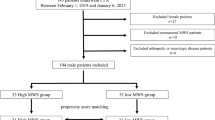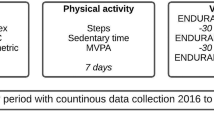Abstract
Patients with pulmonary hypertension (PH) suffer from poor exercise tolerance due to impaired oxygenation and/or reduced cardiac output. However, the relationship between exercise tolerance and physical function remains unclear. The purpose of this study was to investigate the relationship between exercise tolerance and physical function in patients with PH. A total of 94 patients without left heart disease (61.3 ± 14.7 years old, 69.1% females, 22/8/60/4 patients with Group 1/3/4/5 PH) were retrospectively analysed. Physical function was measured using muscle strength (grip strength, knee extension muscle strength), balance function (one-leg standing time), and gait speed within 7 days of cardiac catheterization. Exercise tolerance was measured using the 6-min walking distance (6-MWD). A total of 194 6-MWD measurements and the corresponding physical function were evaluated in 94 patients. Multivariable linear regression analysis using adaptive-LASSO methods indicated that the World Health Organization functional classification, pulmonary vascular resistance, mixed venous oxygen saturation, grip strength, and gait speed were independently associated with the 6-MWD. Low grip strength (< 28 kg for males and < 18 kg for females; adjusted odds ratio and 95% confidence interval: 2.06 [1.30–3.26], p = 0.002), and slow gait speed (< 1.0 m/s for both sexes; 13.33 [3.61–49.19], p < 0.001) were independent predictors of poor exercise tolerance (6-MWD < 440 m) in a logistic regression analysis. Grip strength and gait speed as measures of physical function, pulmonary vascular resistance, and mixed venous oxygen saturation were associated with exercise tolerance in patients with PH without left heart disease.

Similar content being viewed by others
References
Thenappan T, Ormiston ML, Ryan JJ, Archer SL (2018) Pulmonary arterial hypertension: pathogenesis and clinical management. BMJ 360:j5492
Kozu K, Sugimura K, Ito M, Hirata KI, Node K, Miyamoto T, Ueno S, Watanabe H, Shimokawa H, Japanese Pulmonary Circulation Study Group (2020) Current status of long-term prognosis among all subtypes of pulmonary hypertension in Japan. Int J Cardiol 300:228–235
Ruopp NF, Farber HW (2019) The new world symposium on pulmonary hypertension guidelines: should twenty-one be the new twenty-five? Circulation 140:1134–1136
Klinger JR, Elliott CG, Levine DJ, Bossone E, Duvall L, Fagan K, Frantsve-Hawley J, Kawut SM, Ryan JJ, Rosenzweig EB, Sederstrom N, Steen VD, Badesch DB (2019) Therapy for pulmonary arterial hypertension in adults: update of the CHEST guideline and expert panel report. Chest 155:565–586
Babu AS, Arena R, Myers J, Padmakumar R, Maiya AG, Cahalin LP, Waxman AB, Lavie CJ (2016) Exercise intolerance in pulmonary hypertension: mechanism, evaluation and clinical implications. Expert Rev Respir Med 10:979–990
Galiè N, Humbert M, Vachiery JL, Gibbs S, Lang I, Torbicki A, Simonneau G, Peacock A, Vonk Noordegraaf A, Beghetti M, Ghofrani A, Gomez Sanchez MA, Hansmann G, Klepetko W, Lancellotti P, Matucci M, McDonagh T, Pierard LA, Trindade PT, Zompatori M, Hoeper M (2016) 2015 ESC/ERS Guidelines for the diagnosis and treatment of pulmonary hypertension: the joint task force for the diagnosis and treatment of pulmonary hypertension of the European Society of Cardiology (ESC) and the European Respiratory Society (ERS): Endorsed by: Association for European Paediatric and Congenital Cardiology (AEPC), International Society for Heart and Lung Transplantation (ISHLT). Eur Heart J 37:67–119
Nakano Y, Okumura N, Adachi S, Shimokata S, Tajima F, Kamimura Y, Murohara T, Kondo T (2018) Left ventricular end-diastolic dimension and septal e’ are predictors of cardiac index at rest, while tricuspid annular plane systolic excursion is a predictor of peak oxygen uptake in patients with pulmonary hypertension. Heart Vessels 33:521–528
Takei M, Kawakami T, Kataoka M, Kuwahira I, Fukuda K (2019) Residual high intrapulmonary shunt fraction limits exercise capacity in patients treated with balloon pulmonary angioplasty. Heart Vessels 34:868–874
Malhotra R, Bakken K, D’Elia E, Lewis GD (2016) Cardiopulmonary exercise testing in heart failure. JACC Heart Fail 4:607–616
Cicoira M, Zanolla L, Franceschini L, Rossi A, Golia G, Zamboni M, Tosoni P, Zardini P (2001) Skeletal muscle mass independently predicts peak oxygen consumption and ventilatory response during exercise in noncachectic patients with chronic heart failure. J Am Coll Cardiol 37:2080–2085
ATS Committee on Proficiency Standards for Clinical Pulmonary Function Laboratories (2002) ATS statement: guidelines for the six-minute walk test. Am J Respir Crit Care Med 166:111–117
Kamiya K, Masuda T, Matsue Y, Hamazaki N, Matsuzawa R, Tanaka S, Nozaki K, Maekawa E, Noda C, Yamaoka-Tojo M, Matsunaga A, Ako J (2017) Prognostic usefulness of arm and calf circumference in patients ≥65 years of age with cardiovascular disease. Am J Cardiol 119:186–191
Kamiya K, Masuda T, Tanaka S, Hamazaki N, Matsue Y, Mezzani A, Matsuzawa R, Nozaki K, Maekawa E, Noda C, Yamaoka-Tojo M, Arai Y, Matsunaga A, Izumi T, Ako J (2015) Quadriceps strength as a predictor of mortality in coronary artery disease. Am J Med 128:1212–1219
Guralnik JM, Simonsick EM, Ferrucci L, Glynn RJ, Berkman LF, Blazer DG, Scherr PA, Wallace RB (1994) A short physical performance battery assessing lower extremity function: association with self-reported disability and prediction of mortality and nursing home admission. J Gerontol 49:M85–M94
Afilalo J (2019) Evaluating and treating frailty in cardiac rehabilitation. Clin Geriatr Med 35:445–457
Porter TR, Mulvagh SL, Abdelmoneim SS, Becher H, Belcik JT, Bierig M, Choy J, Gaibazzi N, Gillam LD, Janardhanan R, Kutty S, Leong-Poi H, Lindner JR, Main ML, Mathias W Jr, Park MM, Senior R, Villanueva F (2018) Clinical applications of ultrasonic enhancing agents in echocardiography: 2018 American Society of Echocardiography Guidelines Update. J Am Soc Echocardiogr 31:241–274
Graham BL, Steenbruggen I, Miller MR, Barjaktarevic IZ, Cooper BG, Hall GL, Hallstrand TS, Kaminsky DA, McCarthy K, McCormack MC, Oropez CE, Rosenfeld M, Stanojevic S, Swanney MP, Thompson BR (2019) Standardization of spirometry 2019 update. An official American Thoracic Society and European Respiratory Society technical statement. Am J Respir Crit Care Med 200:e70–e88
Chen LK, Woo J, Assantachai P, Auyeung TW, Chou MY, Iijima K, Jang HC, Kang L, Kim M, Kim S, Kojima T, Kuzuya M, Lee JSW, Lee SY, Lee WJ, Lee Y, Liang CK, Lim JY, Lim WS, Peng LN, Sugimoto K, Tanaka T, Won CW, Yamada M, Zhang T, Akishita M, Arai H (2020) Asian Working Group for Sarcopenia: 2019 consensus update on sarcopenia diagnosis and treatment. J Am Med Dir Assoc 21:300–7.e2
Khanal P, He L, Stebbings GK, Onambele-Pearson GL, Degens H, Williams AG, Thomis M, Morse CI (2021) Static one-leg standing balance test as a screening tool for low muscle mass in healthy elderly women. Aging Clin Exp Res 33:1831–1839
Kanda Y (2013) Investigation of the freely available easy-to-use software “EZR” for medical statistics. Bone Marrow Transplant 48:452–458
Bellofiore A, Dinges E, Naeije R, Mkrdichian H, Beussink-Nelson L, Bailey M, Cuttica MJ, Sweis R, Runo JR, Keevil JG, Francois CJ, Shah SJ, Chesler NC (2017) Reduced haemodynamic coupling and exercise are associated with vascular stiffening in pulmonary arterial hypertension. Heart 103:421–427
Marini C, Formichi B, Bauleo C, Michelassi C, Airò E, Rossi G, Giuntini C (2016) Survival protection by bodyweight in isolated scleroderma-related pulmonary artery hypertension. Intern Emerg Med 11:941–952
Izawa KP, Watanabe S, Oka K, Hiraki K, Morio Y, Kasahara Y, Watanabe Y, Katata H, Osada N, Omiya K (2012) Upper and lower extremity muscle strength levels associated with an exercise capacity of 5 metabolic equivalents in male patients with heart failure. J Cardiopulm Rehabil Prev 32:85–91
Kaymaz D, Candemir İÇ, Ergün P, Demir N, Taşdemir F, Demir P (2018) Relation between upper-limb muscle strength with exercise capacity, quality of life and dyspnea in patients with severe chronic obstructive pulmonary disease. Clin Respir J 12:1257–1263
Porto JM, Nakaishi APM, Cangussu-Oliveira LM, Freire Júnior RC, Spilla SB, Abreu DCC (2019) Relationship between grip strength and global muscle strength in community-dwelling older people. Arch Gerontol Geriatr 82:273–278
Pradon D, Roche N, Enette L, Zory R (2013) Relationship between lower limb muscle strength and 6-minute walk test performance in stroke patients. J Rehabil Med 45:105–108
Hayashi D, Gonçalves CG, Parreira RB, Fernandes KBP, Teixeira DC, Silva RA, Probst VS (2012) Postural balance and physical activity in daily life (PADL) in physically independent older adults with different levels of aerobic exercise capacity. Arch Gerontol Geriatr 55:480–485
Kamiya K, Hamazaki N, Matsue Y, Mezzani A, Corra U, Matsuzawa R, Nozaki K, Tanaka S, Maekawa E, Noda C, Yamaoka-Tojo M, Matsunaga A, Masuda T, Ako J (2018) Gait speed has comparable prognostic capability to six-minute walk distance in older patients with cardiovascular disease. Eur J Prev Cardiol 25:212–219
DePew ZS, Karpman C, Novotny PJ, Benzo RP (2013) Correlations between gait speed, 6-minute walk distance, physical activity, and self-efficacy in patients with severe chronic lung disease. Respir Care 58:2113–2211
Yee XS, Ng YS, Allen JC, Latib A, Tay EL, Abu Bakar HM, Ho CYJ, Koh WCC, Kwek HHT, Tay L (2021) Performance on sit-to-stand tests in relation to measures of functional fitness and sarcopenia diagnosis in community-dwelling older adults. Eur Rev Aging Phys Act 18:1
Del Buono MG, Arena R, Borlaug BA, Carbone S, Canada JM, Kirkman DL, Garten R, Rodriguez-Miguelez P, Guazzi M, Lavie CJ, Abbate A (2019) Exercise intolerance in patients with heart failure: JACC state-of-art review. J Am Coll Cardiol 73:2209–2225
Gosker HR, Zeegers MP, Wouters EFM, Schols AMWJ (2007) Muscle fibre type shifting in the vastus lateralis of patients with COPD is associated with disease severity: a systematic review and meta-analysis. Thorax 62:944–949
Breda AP, Pereira de Albuquerque AL, Jardim C, Morinaga LK, Suesada MM, Fernandes CJ, Dias B, Lourenço RB, Salge JM, Souza R (2014) Skeletal muscle abnormalities in pulmonary arterial hypertension. PLoS One 9:e114101
Acknowledgements
We would like to thank Editage (www.editage.com) for English language editing.
Author information
Authors and Affiliations
Corresponding author
Ethics declarations
Conflict of interest
The authors declare that they have no conflict of interest.
Ethics approval
This study was performed in line with the principles of the World Medical Association and the Declaration of Helsinki and its later amendments. Approval was granted by the Ethics Committee of Yokohama City University (approval number: B191200038).
Informed consent
The requirement for written informed consent was waived because of the retrospective study design. Informed consent was obtained by using the opt-out method.
Additional information
Publisher's Note
Springer Nature remains neutral with regard to jurisdictional claims in published maps and institutional affiliations.
Supplementary Information
Below is the link to the electronic supplementary material.
Rights and permissions
About this article
Cite this article
Okamura, M., Konishi, M., Saigusa, Y. et al. Impact of grip strength and gait speed on exercise tolerance in patients with pulmonary hypertension without left heart disease. Heart Vessels 37, 1928–1936 (2022). https://doi.org/10.1007/s00380-022-02091-2
Received:
Accepted:
Published:
Issue Date:
DOI: https://doi.org/10.1007/s00380-022-02091-2




